Disclosure: This article contains affiliate links. We may earn a commission from purchases at no extra cost to you, which helps our travel content.
The first time I witnessed the windmills of Kinderdijk bathed in golden light, I understood why UNESCO deemed this landscape worthy of preservation. Nineteen 18th-century windmills standing sentinel along the polders, their wooden arms occasionally turning against a backdrop of impossibly Dutch skies—it's a photographer's dream that demands more than just pointing and shooting. Having photographed mountains across five continents, I can confidently say that capturing these humble structures requires similar reverence and technical finesse. Let me guide you through the perfect photographic weekend in Kinderdijk, where engineering marvel meets natural splendor in a dance of light and shadow.
Planning Your Photographic Pilgrimage
Kinderdijk sits just 15km east of Rotterdam, making it an accessible weekend escape for couples seeking both romance and photographic opportunities. While day-trippers arrive by the busload between 10am and 4pm, the true photographer knows that magic happens at the edges of the day.
I recommend basing yourself in Rotterdam and rising early to catch the first light. The electric scooter rental offers a delightful way to arrive—silent and unobtrusive, allowing you to glide into position before the crowds descend. Alternatively, the water bus from Rotterdam provides a scenic approach that contextualizes these windmills' relationship with the water they were built to manage.
Accommodation in Kinderdijk itself is limited, but the nearby village of Alblasserdam offers charming B&Bs that provide easy access for those dawn expeditions. When my partner joined me last spring, we found that splitting our stay between Rotterdam's urban energy and Alblasserdam's quaint tranquility created a perfect balance.
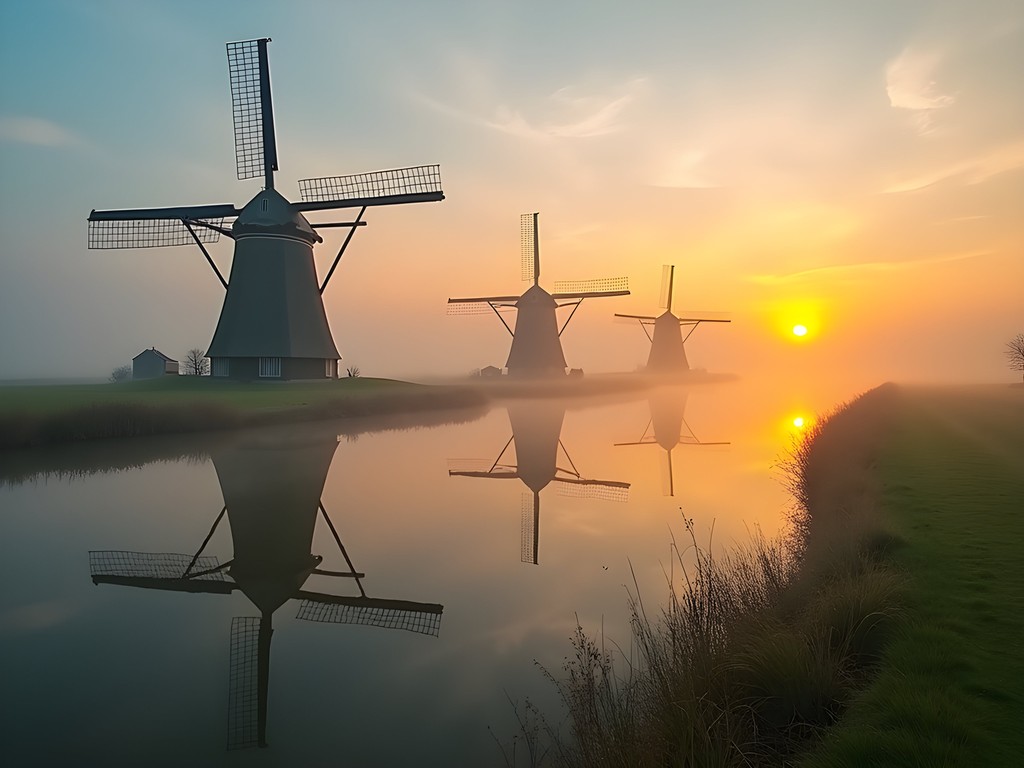
💡 Pro Tips
- Book accommodations in Rotterdam for urban exploration and Alblasserdam for early morning access
- Purchase tickets online to skip queues and save time for photography
- Visit mid-week in spring for fewer crowds and beautiful light conditions
Golden Hour Secrets of Kinderdijk
Golden hour at Kinderdijk transforms these functional structures into silhouettes of poetry. Having photographed golden hour across five continents, I can attest that Kinderdijk offers something uniquely magical—the interplay of water, sky, and these distinctive human-made forms creates compositions that feel both timeless and dynamic.
My preferred shooting times are 30 minutes before sunrise until about an hour after, then again from an hour before sunset until twilight fades. During my last visit in April, I found myself alone with the windmills at 6:15am, watching the first light catch their sails while ducks created ripples across perfectly reflective waters.
For stability during these low-light conditions, I rely on my carbon fiber tripod which handles the occasionally breezy conditions without vibration. A good remote shutter release is also essential for those long exposures when even touching the camera can introduce shake.
Don't rush from one windmill to the next. I spent an entire hour at Windmill No. 2, watching as the changing light transformed it from a shadowy form to a detailed structure revealing centuries of craftsmanship.
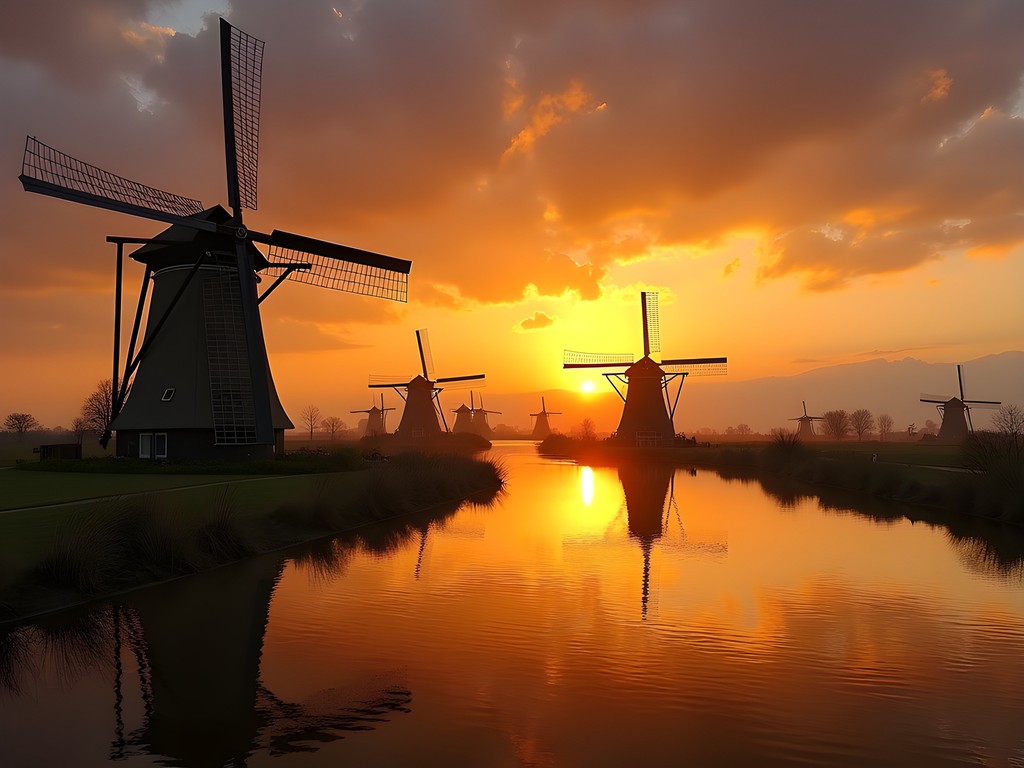
💡 Pro Tips
- Arrive at least 30 minutes before sunrise to set up your equipment in the best locations
- Use the PhotoPills app to plan exact sun position relative to specific windmills
- Bring graduated neutral density filters to balance bright skies with darker foregrounds
Composition Techniques for Windmill Photography
The uniform spacing of Kinderdijk's windmills presents both opportunity and challenge for compelling composition. After years of photographing repetitive elements—from Himalayan prayer flags to Australian rock formations—I've learned that finding visual rhythm is key.
Try these approaches I've refined over multiple visits:
Leading Lines: The canals and footpaths create natural leading lines that draw the viewer's eye through your image. Position yourself where these lines converge with windmills for powerful compositions.
Reflections: Spring brings calm mornings ideal for capturing mirror images in the still waters. Get low to the ground—I often find myself kneeling at water's edge with my camera just centimeters above the surface.
Framing: Use the arms of one windmill to frame another in the distance. This creates depth and context while showcasing their mechanical design.
Human Element: Including your partner in the frame provides scale and emotional connection. I often position my partner as a small figure gazing toward the windmills, creating both scale and narrative.
For those longer exposures that capture moving windmill sails or cloud movement, I recommend using a variable ND filter which allows you to adjust exposure length without changing your carefully composed frame.
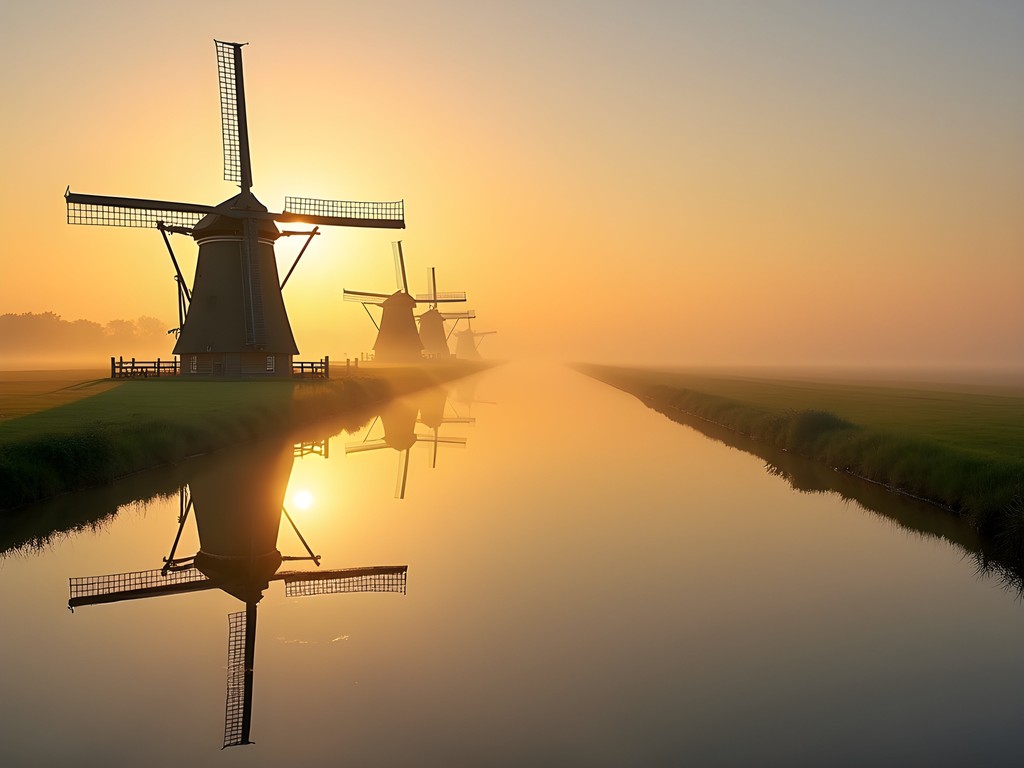
💡 Pro Tips
- Use the rule of thirds to position windmills at intersection points rather than center frame
- Incorporate diagonal lines from windmill arms to create dynamic tension
- Experiment with extreme wide angle (16mm) and telephoto (200mm) perspectives for variety
Beyond the Postcard: Intimate Details & Stories
While the classic wide shots of windmill rows are essential, my artistic background draws me to the intimate details that tell deeper stories. The weathered wood grain of a 250-year-old sail arm. The contrast between ancient mechanisms and modern conservation techniques. The resident miller's wooden clogs resting by the door.
During my third visit to Kinderdijk, I spent an afternoon with Hendrik, a volunteer who maintains Windmill No. 5. His hands—cracked and calloused from restoration work—became the subject of a photo series that connected human craft to these historic structures. These intimate portraits often tell more about a place than grand landscapes.
For detail work, I recommend carrying a macro lens to capture the intricate woodwork and mechanical elements. The lens cleaning kit is also essential in this environment where wind can carry dust and pollen onto your glass.
Don't forget to document the surrounding flora—especially in spring when tulips and other Dutch flowers create foreground interest. The polders between windmills burst with wildflowers that add color contrast to the predominantly earth-toned structures.
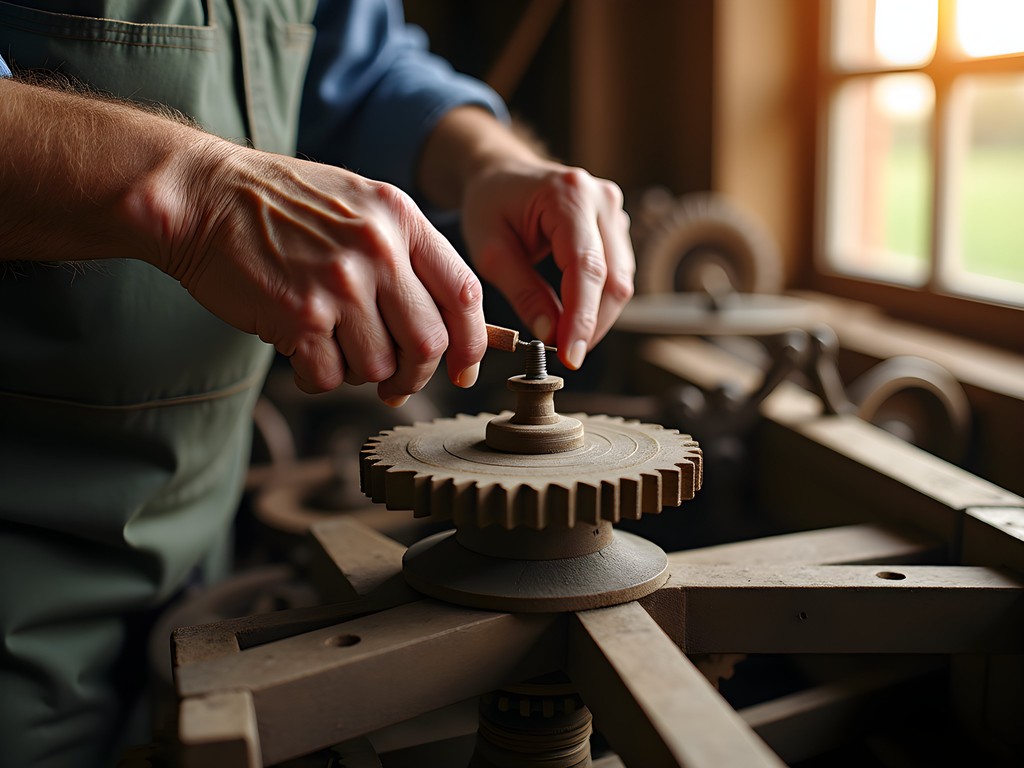
💡 Pro Tips
- Visit the museum windmill to photograph interior mechanisms and living quarters
- Focus on interactions between visitors and windmills to tell human stories
- Use a polarizing filter to manage reflections when photographing windmill details
Practical Considerations for Photography Couples
Visiting Kinderdijk as a photography-focused couple requires balancing creative pursuits with relationship harmony—something my partner and I have refined through many photographic expeditions.
While the site is compact enough to explore on foot, the full circuit spans 3km. For couples with different energy levels or carrying heavy gear, consider renting bicycles on-site to move efficiently between shooting locations. I've found that the camera backpack comfortably distributes weight during longer shooting sessions while providing quick access to gear without setting everything down.
Kinderdijk offers limited dining options, so pack a romantic picnic to enjoy between shooting sessions. We discovered a perfect willow-shaded spot near Windmill No. 7 that offers both privacy and a spectacular view. The insulated picnic backpack keeps champagne chilled and strawberries fresh while doubling as extra padding for camera gear.
Communicate your photography priorities with your partner before arriving. My technique is to identify 3-5 'must-have' shots that might require patience or specific timing, while remaining flexible about the rest. This prevents the frustration of one partner feeling like a photography assistant rather than a travel companion.
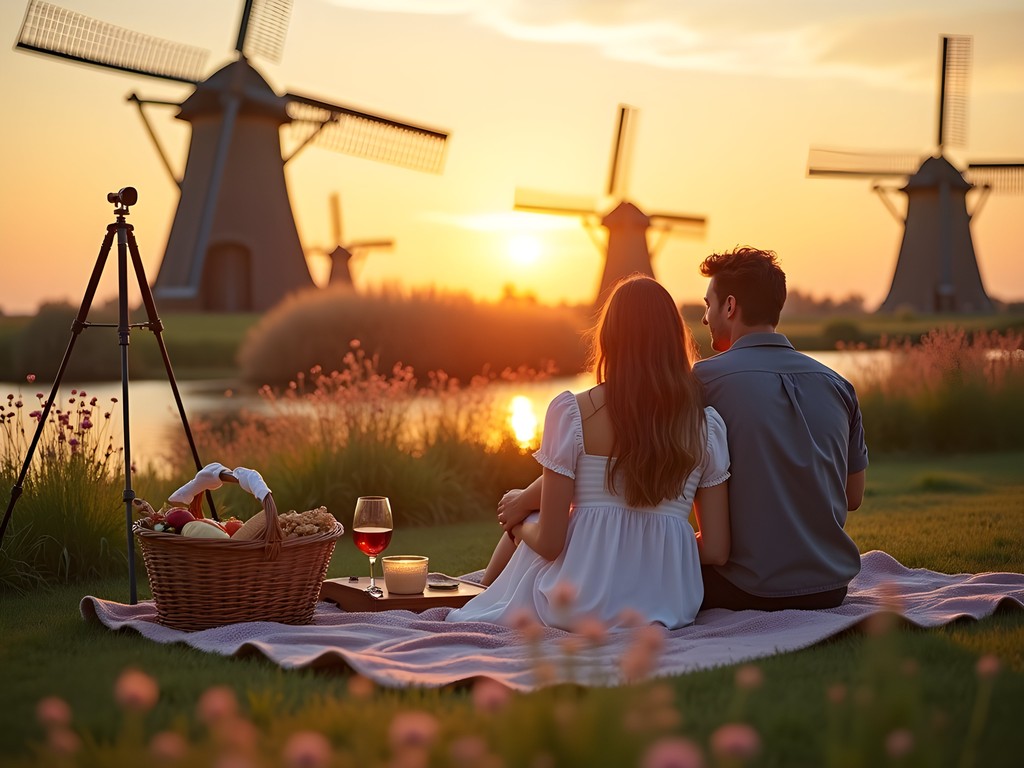
💡 Pro Tips
- Take turns being photographer and model to ensure both partners enjoy the experience
- Schedule non-photography activities in harsh midday light when conditions aren't ideal
- Visit the Kinderdijk visitor center first for orientation and to plan optimal shooting locations
Final Thoughts
As the day ends and blue hour descends upon Kinderdijk, I find myself reluctant to pack away my camera, knowing each shifting cloud brings new compositional possibilities. Yet there's also joy in simply experiencing this place—in watching my partner's face illuminate with the same golden light that touches the windmills, in feeling the connection between past and present that these structures embody.
Kinderdijk reminds us that photography is not just about technical mastery but about seeing—truly seeing—the interplay of light, history, and human ingenuity. These windmills have stood for centuries, their reflection in canal waters a meditation on permanence and change. Our photographs, like the windmills themselves, are attempts to harness something ephemeral—light, time, emotion—and transform it into something that endures.
Return in different seasons, different weather, different light. Each visit will reveal new perspectives, new stories. And between clicks of the shutter, remember to lower your viewfinder occasionally and simply absorb the beauty that drew you to capture it in the first place. Kinderdijk isn't just a photography destination—it's a masterclass in seeing the extraordinary in the seemingly ordinary, a skill that will transform your photography far beyond these Dutch polders.
✨ Key Takeaways
- Golden hour (sunrise and sunset) offers the most magical lighting conditions for windmill photography
- Explore both classic landscape compositions and intimate detail shots to tell a complete visual story
- Balance dedicated photography time with moments to simply experience the place with your partner
- Return in different seasons to capture diverse moods and lighting conditions
📋 Practical Information
Best Time to Visit
Mid-April to early June for ideal light and spring blooms
Budget Estimate
€150-250 per day including accommodation, transportation and meals
Recommended Duration
2-3 days minimum for varied lighting conditions
Difficulty Level
Moderate (Requires Early Mornings And Some Walking)

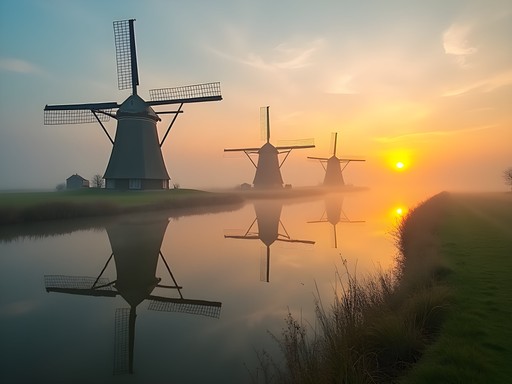







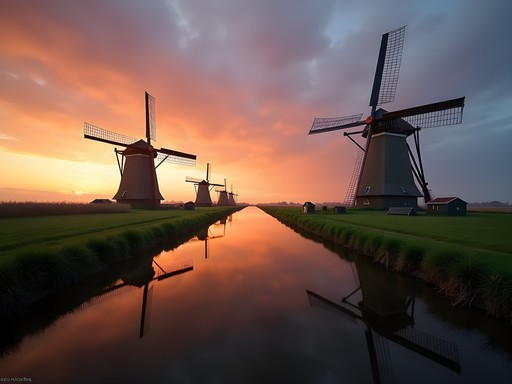






Comments
smartadventurer
Going to Netherlands next month and definitely adding Kinderdijk to my itinerary after seeing this! Is it easy to reach by public transport from Rotterdam?
cityclimber
Not the author but I did this trip last year! Super easy - just take the waterbus from Rotterdam. It's a scenic ride and drops you right at the windmills. Way better than dealing with parking!
smartadventurer
Thanks for the tip! Waterbus sounds perfect.
adventurevibes
These photos are INCREDIBLE! Major wanderlust right now 😍
coolwanderer2119
Just got back from Kinderdijk last month and your golden hour tips would've saved me so much time! I spent three evenings trying to get the perfect shot, but kept missing the best light. That section about positioning yourself along the canal for reflections was spot on though - ended up with some decent shots despite my poor timing. Did you find the crowds manageable during sunset?
Amit Sanchez
Thanks for reading! The crowds can definitely be challenging, especially in summer. I found arriving 1-2 hours before actual sunset helps secure prime spots. The tour groups usually clear out by then!
coolwanderer2119
Wish I'd known that! Will definitely try your approach next time. The place is magical when you get it right.
bluediver
Your photos are STUNNING!! 😍 I'm a total photography newbie but heading to Netherlands next month. Is Kinderdijk doable as a day trip from Amsterdam? And will my phone camera be good enough or should I invest in something better?
coffeebackpacker
Not the author but I did this trip last year! Definitely doable from Amsterdam - about 1.5 hours each way. Your phone will capture great shots, especially newer models with night mode.
bluediver
Thank you so much! That's super helpful! I've got the latest iPhone so sounds like I should be fine. Can't wait!
Frank Garcia
Amit, your composition techniques section is spot on! I visited Kinderdijk last autumn and discovered that arriving 30 minutes before official golden hour gave me time to scout locations and set up. The water reflection shots are tricky - I found success on calmer days by positioning along the eastern canal where there's less boat traffic. Also worth noting for photographers: the visitor center has lockers if you're carrying extra gear, and the paths can get muddy after rain so appropriate footwear is essential. I used my tripod which was perfect for the low-light conditions as golden hour transitions to blue hour. Did you find any particular focal length worked best for capturing both the grandeur and details of the windmills?
bluediver
Frank - did you try any drone photography there? Wondering if it's allowed or worth bringing one.
Frank Garcia
Drones are actually restricted there since it's a UNESCO site. There are some designated areas where it's permitted with proper authorization, but honestly, the ground-level compositions are so strong that I didn't miss having aerial shots.
coffeebackpacker
Those golden hour shots are incredible! Definitely adding Kinderdijk to my bucket list.
Frank Garcia
Worth prioritizing! I was there last autumn and the light is genuinely magical. Just be prepared for crowds during peak season.
coffeebackpacker
Thanks for the tip! Any specific month you'd recommend to avoid the worst crowds?
Frank Garcia
Late September or early October was perfect - still decent weather but noticeably fewer tourists. Plus the early sunset means golden hour happens at a reasonable time!
photoninja
Great post! I visited Kinderdijk in September and can confirm that polarizing filter is essential for those water reflections. One thing I'd add - don't forget to explore the interior of the museum windmill. I got some beautiful shots of the wooden gears and mechanisms with the light streaming through the small windows. Creates this amazing atmosphere that tells the story of the place beyond just the iconic exterior views. Amit, did you try any night photography there? I'm curious about access after hours.
Amit Sanchez
Great point about the interiors! I didn't get to do proper night photography as the site officially closes at dusk, though I did catch some blue hour shots. From what I understand, they sometimes have special evening events where photography might be possible.
greennomad
YESSS! Kinderdijk was the highlight of my Netherlands trip! Those windmills against that golden sky - pure magic! Your composition tips really helped me frame some killer shots. Can't believe how the light bounces off the water at that time of day. Seriously people, follow Amit's advice about getting there 1-2 hours before sunset. WORTH IT!
Frank Garcia
Just returned from Netherlands last week and followed your advice about visiting Kinderdijk - the results were phenomenal. I'd add that weather tracking is crucial here. I used weather app to monitor cloud coverage patterns and waited for a day with scattered clouds rather than clear skies. The broken cloud effect created dramatic light shafts that really elevated my compositions. Also worth noting: the boat tour is great for unique perspectives, but for serious photography, walking the paths gives you more flexibility to wait for the perfect light. Spent 4 hours there and could have stayed longer!
sunsetace
Is it super crowded during golden hour? Wondering if I need to arrive early to get a good spot.
Amit Sanchez
It can get busy, especially in summer, but the path is long enough that you can usually find good spots. Weekdays are definitely less crowded than weekends!
Venture X
Premium card with 2X miles, $300 travel credit, Priority Pass